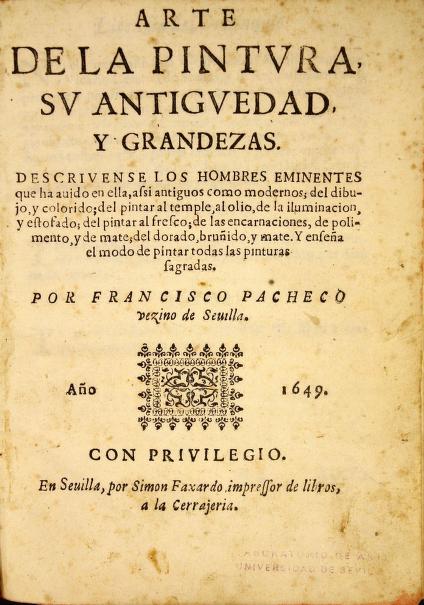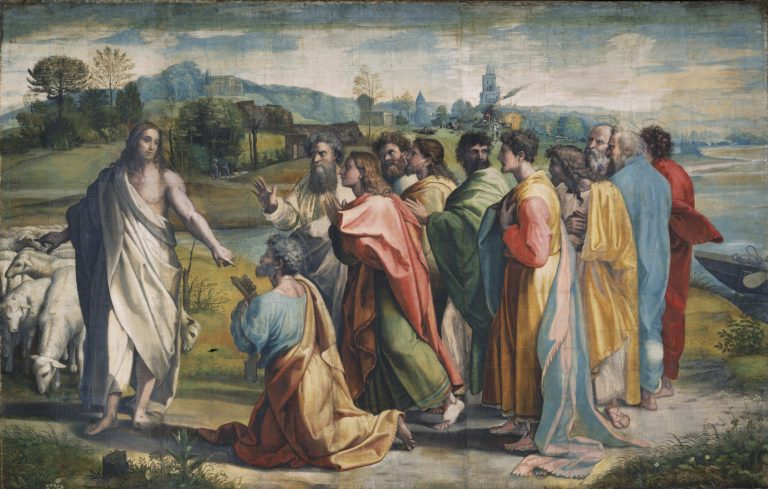
Frostispiece of Pacheco, El Arte de la pintura (1649), Seville, Simon Faxardo, impressor de libros, a la Cerrajeria
Dealing with the story of St. Peter (Apostle), Pacheco analyses the correct way of representing the saint, not just presenting a few models to follow, but also some inadequate manners of depicting specific scenes/elements of the saint’s life, such as depicting St. Peter bald or tied to the cross with cords.
“Molano says that Peter, Prince of the Apostolic Senate, has the right side of the Lord. In these most ancient and venerable paintings of the Church, from the time of Constantine and Luke the Evangelist, it is quite well-founded and assured that St. Peter was not painted bald, as is most common, although others say otherwise, but with his forehead full of hair, not long, with his ponytail, although together with the round, grey, frizzy and thick beard. Raphael followed this effigy in his Apostles. […] And perhaps it has not been observed until now why he is painted one in gold and the other in silver, as is seen in many churches in Italy and Rome; by the golden key is meant the power of absolution; by the silver one, that of ex-communication, because the latter is inferior and the former, superior […]. About the manner of crucifying him, after he and St. Paul were scourged, in two columns which are shown in Santa Maria Transpontine, a Carmelite church in Rome”, we will notice that, although some depict him tied to the cross with cor deals, he was crucified like Christ with nails, as the saints and authors affirm; and it is an evident demonstration taken from the custom of the Romans. And so Egesippus says that having arrived at the cross, he asked to be nailed upside down because he was unworthy to be crucified like his Master; […] We said above that, according to the painting of St. Luke, St. Peter was not bald, and we say the same of St. Paul, but rather, on the forehead, his hair is shown parted in the Nazarene manner and he and his beard are black, although his face is white, more so than that of St. Peter”.
“[…] , dice Molano, que Pedro, Príncipe del Senado apostólico, tenga el lado derecho del Señor. En estas más antiguas y venerables pinturas de la Iglesia, del tiempo de Constantino y de Lucas Evangelista, se funda y asegura, bastantemente, no haberse de pintar calvo San Pedro como es lo más común, aunque otros digan otra cosa, sino poblada la frente de cabello no largo, con su coleta, si bien juntamente con la barba redonda, cana, crespa y espesa. Esta efigie siguió Rafael en sus Apóstoles. […] Y quizá no se ha observado hasta ahora por qué le pintan la una de oro y la otra de plata, como se ven en muchas iglesias de Italia y Roma; por la llave de oro se entiende la potestad de la absolución; por la de plata, la de la excomunión, porque ésta es inferior y aquélla, superior.[…] En lo que toca al modo de crucificarle, después de ser azotados él y San Pablo, en dos colunas que se muestran en Santa Maria Transpontina, iglesia de carmelitas en Roma”, advertiremos que, aunque algunos le pintan atado a la cruz con cor deles, fue crucificado como Cristo con clavos, como afirman los santos y autores; y es demonstración evidente sacada de la costumbre de los romanos. Y, así Egesipo dice que, llegado a la cruz, pidió que lo enclavaran al revés, porque era indigno de ser crucificado como su Maestro;[…] Diximos arriba que, conforme a la pintura de San Lucas, no fue calvo San Pedro, lo mismo decimos de San Pablo, sino antes, en la frente se muestra el cabello partido a lo nazareno y negro él y la barba, si bien del rostro el color es blanco, más que el de San Pedro.”

Pacheco (1990), 667, n. 31; Pacheco (1990), 668, n. 32; Pacheco (1990), 669, n. 34;



